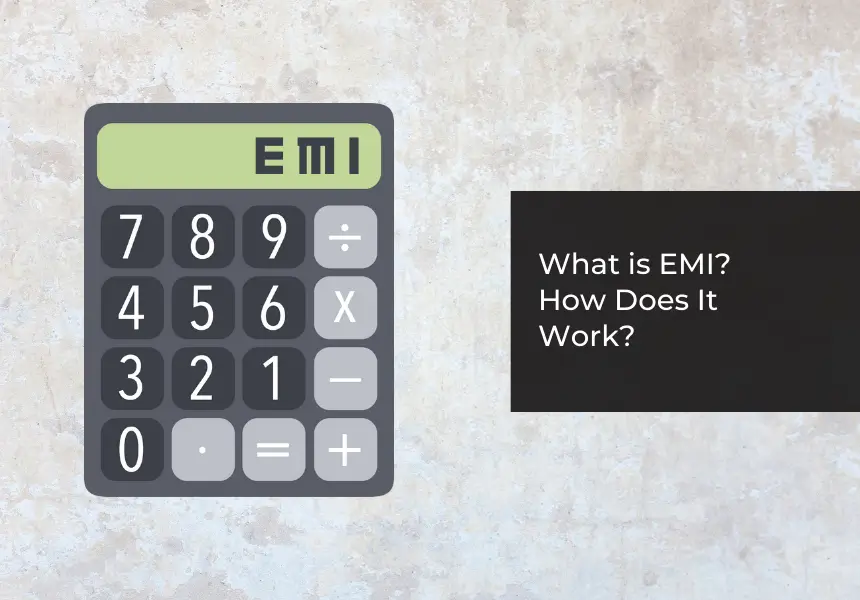
Have you ever dreamt of buying a new car or home, but the price tag overwhelmed you? Being able to pay in EMIs can turn dreams to reality.
Let’s understand EMI and how it works in detail, making it less like a financial mystery and more like a manageable tool to reach your goals.
What is an EMI?
EMI, or Equated Monthly Installment, is the fixed payment a borrower makes to a lender on a monthly basis to repay a loan.
The EMI offers a structured and predictable repayment plan, allowing borrowers to budget and manage their finances properly. Repaying a loan in EMIs can help borrowers budget and manage their finances well. The EMI amount includes the principal amount borrowed and the interest amount, guaranteeing that the loan is returned in equal installments over the agreed-upon period.
How does an EMI work?
When you borrow money through a loan, like a personal loan or a home loan, your monthly payment (EMI) is calculated based on three factors:
- Loan amount: The total sum you borrow.
- Interest rate: The cost of borrowing the money, expressed as a percentage.
- Loan tenure: The total duration (in months or years) over which you must repay the loan.
Each EMI payment you make includes two things:
- Principal repayment: A portion goes towards paying back your borrowed amount.
- Interest: The remaining portion covers the interest charged on the loan.
Initially, a larger share of your EMI pays the interest with a smaller principal amount. As you continue making payments, the situation gradually flips. The interest amount decreases, while a greater portion goes towards principal repayment. This ensures the loan gets paid off steadily.
Moreover, paying your EMIs on time is important for two reasons:
- Maintains a good credit score: Timely payments demonstrate your creditworthiness and help build a good credit score, which benefits you when applying for future loans.
- Helps you avoid penalties: Late payments often incur additional charges, so timely payments save you money.
The loan tenure you choose affects your EMI amount. Here’s the trade-off:
- Longer tenure: Lower EMI, but you pay more interest overall.
- Shorter tenure: Higher EMI, but you save on interest in the long run.
Choosing the right tenure depends on your financial situation and budget.
How is EMI Calculated?
The loan term (the number of months over which the loan must be repaid), interest rate, and loan amount are used to calculate the EMI. Let’s break down the steps to calculate EMI:
- Principal loan amount (P)
- Annual interest rate (r). The annual interest rate is divided by 12 (months in a year)
- Loan tenure in months (n)
Add the values to the EMI formula: EMI = [P x r x (1+r)n]/[(1+r)n-1]
Let’s understand the formula in detail:
- Principal Loan Amount (P): This is the total amount borrowed. The EMI calculation starts with this amount.
- Monthly Interest Rate (r): This is calculated from the annual interest rate. This rate assesses the interest payable on the outstanding loan amount each month.
- Number of Monthly Installments (n): This is the total number of months over which the loan must be repaid.
The EMI calculation ensures that the principal and interest are paid off in equal monthly installments over the loan’s term.
Factors affecting your EMI payments
The EMI you pay on a loan might vary depending on a number of factors:
- Loan Amount: The EMI increases with the amount of the loan.
- Interest Rate: The EMI is directly impacted by the interest rate that the lender charges. EMIs increase in response to increasing interest rates.
- Loan Tenure: Lower EMIs are associated with longer loan terms, while higher EMIs are associated with shorter terms.
- Repayment Ability: When calculating the EMI you can afford, lenders take your debt-to-income ratio and monthly income into consideration.
- Credit Score: Higher credit score borrowers can be eligible for reduced interest rates, meaning lower EMIs.
- Loan Type: The interest rates and EMI schedules for various loan kinds, such as auto, housing, and personal loans, may differ.
Strategies for reducing your personal loan EMIs
Consider the following strategies if you want to lower your personal loan EMIs:
Negotiate the Interest Rate: Try negotiating with the lender for a lower interest rate; this can immediately reduce your monthly installment.
Extend the Loan Tenure: choosing a longer tenure can reduce your monthly EMIs.
Make Payments: You can reduce your EMIs by making extra lump-sum principal payments, reducing the outstanding loan amount.
Explore Balance Transfer Options: Consider moving the balance to a loan with a lower interest rate.
Option for Step-Up EMI: Certain lenders offer a step-up EMI structure, in which the EMI is initially lower and progressively rises over the loan’s duration.
Conclusion
EMIs are fixed monthly instalments used to repay a loan or debt. Factors like the loan amount, interest rate, and tenure affect the EMI amount. So, whether you are planning to buy a new car or your dream home, choosing the best EMI plan lets you manage your loan effectively.
Frequently Asked Questions
What’s the difference between EMI and interest?
An EMI is a total monthly payment that includes the principal and interest components, while interest is the cost of borrowing the money.
Can I prepay my loan to reduce the EMI?
Yes, making additional payments towards the principal can lower your outstanding loan amount and reduce the EMI.
Why is EMI important in personal finance?
EMI is important because it establishes the monthly repayment obligation for different loans. It is essential for financial planning and budgeting.
What happens if I miss an EMI payment?
If you miss making an EMI payment, you might have to pay late fees and your credit score will be negatively affected as well.
Can I switch lenders to get a lower EMI?
Yes, you can look into balance transfer options to transfer your loan to a lender with a reduced interest rate, which would lower your monthly instalment amount.








